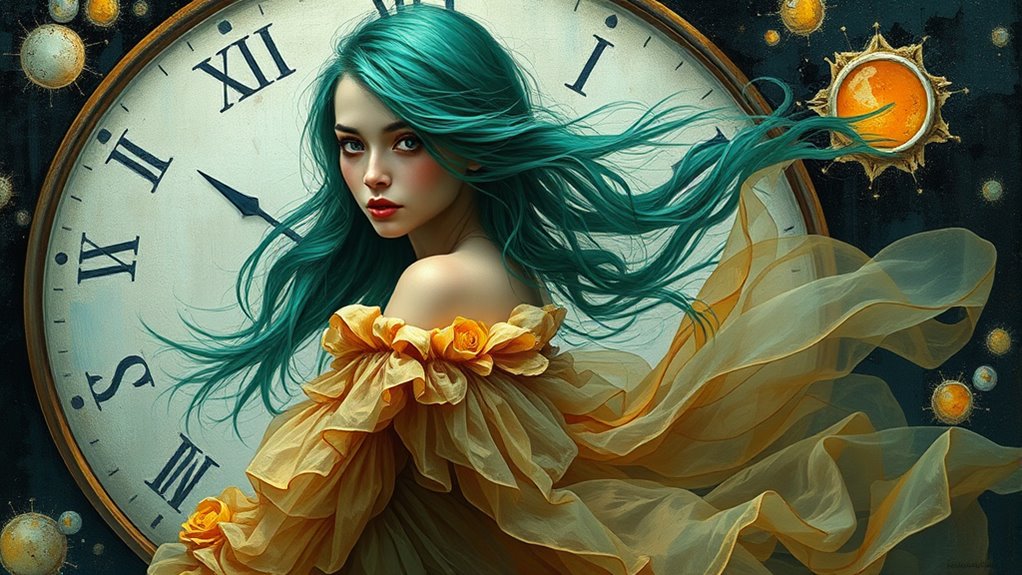Women surrealists have had a powerful impact on modern art by using dreamlike imagery and symbolic elements to challenge societal norms and explore themes of gender and identity. Artists like Frida Kahlo, Leonora Carrington, and Dora Maar transformed personal pain and subconscious thoughts into visionary works that broke traditional boundaries. Their innovative approaches continue to influence contemporary artists and shape discussions around feminism and societal change. Stay with us to discover more about these influential artists and their lasting legacies.
Key Takeaways
- Women surrealists significantly influenced modern art by integrating dream symbolism, feminist perspectives, and challenging societal norms.
- Notable figures like Frida Kahlo, Leonora Carrington, and Dora Maar used surreal imagery to explore identity, subconscious fears, and gender roles.
- Their work served as a response to societal marginalization, transforming personal pain into powerful visual narratives.
- They broke artistic taboos, redefining surrealism as a platform for feminist expression and social critique.
- Their innovative techniques and themes continue to inspire contemporary artists and shape discussions on gender and identity.

While Surrealism is often associated with groundbreaking male artists, women played an essential role in shaping the movement and transforming modern art. You might not always hear their names in mainstream narratives, but their contributions are undeniable. These women harnessed dream symbolism to explore subconscious thoughts and emotions, pushing the boundaries of artistic expression. They used surreal imagery to challenge societal norms and reveal hidden truths, often infused with feminist perspectives that questioned gender roles and power structures. Their work was a direct response to a world that marginalized women, turning personal experiences into powerful statements.
Women’s surrealist art challenged norms, revealing truths and empowering voices often overlooked in mainstream narratives.
You can see this clearly in the art of women like Frida Kahlo, whose paintings blend dreamlike symbolism with raw emotional honesty. Kahlo’s work often depicts her personal pain and identity struggles, transforming her experiences into visual narratives that resonate beyond her time. Her use of surreal elements, like distorted figures and symbolic animals, invites you to interpret her inner world through the lens of dream symbolism, all while subtly addressing feminist perspectives that challenge traditional notions of femininity. These images serve as a form of resistance, asserting her individuality in a male-dominated art scene.
Another influential figure is Leonora Carrington, whose imaginative worlds are filled with mythic creatures and fantastical landscapes. Her art reflects a deep engagement with the subconscious, creating dreamscapes that defy logic and challenge your perception of reality. Carrington’s work often explores themes of feminine mysticism and liberation, positioning her as a key voice in feminist surrealism. She used surrealist techniques to reveal the complexity of female identity and experience, encouraging you to question societal expectations and explore your own subconscious fears and desires.
Dora Maar, known for her association with Picasso, also made significant contributions through her own surrealist photography and paintings. Her images often feature layered symbolism and dream motifs that explore psychological depth. Maar’s feminist perspective emerges in her portrayal of women as powerful, complex figures rather than mere muses or objects. Her work pushes you to see women as active creators and thinkers, challenging traditional stereotypes. By integrating dream symbolism into her art, she invites you to explore into the subconscious and confront issues of gender and identity.
Together, these women transformed surrealism into a platform for feminist expression. Their innovative use of dream symbolism enabled them to communicate complex ideas about gender, identity, and liberation. They broke societal taboos and redefined what modern art could be, ensuring their voices continue to influence artists today. Your appreciation of surrealism deepens when you recognize the crucial contributions women made, turning subconscious visions into powerful tools for social change.
Frequently Asked Questions
How Did Women Surrealists Influence Contemporary Feminist Art?
Your question explores how women surrealists influenced contemporary feminist art. They challenged traditional gender representation by pushing boundaries and embracing artistic innovation, inspiring others to question societal norms. Their work highlights personal and collective experiences, opening space for diverse voices. By doing so, they paved the way for modern feminist artists to explore identity, gender, and power dynamics, fostering greater inclusivity and transforming the art world’s approach to gender and expression.
What Challenges Did Women Surrealists Face in Male-Dominated Art Circles?
Oh, the joys of artistic censorship and gender bias! You’d think in the vibrant world of art, women would be celebrated, not sidelined. Instead, you face constant obstacles, like being dismissed or silenced in male-dominated circles. Surrealist women had to challenge stereotypes, break barriers, and fight for recognition, all while battling the persistent notion that their creativity was lesser. It’s a struggle rooted in bias, yet their resilience reshaped modern art.
Which Women Surrealists Were Most Active During the 1920S and 1930S?
During the 1920s and 1930s, you’ll find women surrealists like Leonora Carrington and Remedios Varo actively creating art. They explored abstract landscapes and dream imagery, pushing boundaries in a male-dominated scene. Carrington’s imaginative scenes and Varo’s mystical compositions stand out, reflecting their unique visions. These artists contributed profoundly to surrealism’s evolution, inspiring future generations with their innovative use of abstract landscapes and dream imagery.
How Did Women Surrealists’ Personal Lives Impact Their Artistic Careers?
Your personal struggles deeply influenced your artistic evolution, shaping the way you express subconscious thoughts and emotions. These challenges often fueled your creative energy, pushing you to explore new techniques and ideas. By channeling your experiences into your art, you gain greater insight and authenticity. Your personal life becomes intertwined with your work, allowing you to create powerful, impactful pieces that reflect both your inner world and your growth as an artist.
Are There Any Hidden or Lesser-Known Women Surrealists Worth Exploring?
Imagine uncovering a buried treasure chest filled with hidden talents—these obscure figures, lesser-known women surrealists, beckon exploration. You might find inspiring works from women whose contributions are often overlooked, yet they considerably shaped surrealism’s evolution. Explore their stories, art, and ideas, and you’ll discover a rich tapestry of creativity waiting to be recognized. Their unique perspectives add depth and diversity to the surrealist movement you’re eager to understand.
Conclusion
As you admire the mesmerizing masterpieces of women surrealists, you’ll realize their rebellious, radiant reign reshaped modern art. Their fearless finesse, fantastical visions, and fierce feminism fuel future generations’ fire. By breaking barriers and boldly bridging boundaries, these women continue to inspire innovation and ignite imagination. Remember, their remarkable resilience and revolutionary roles remain a rallying reminder that art’s true power lies in pushing perspectives and pioneering progress.









